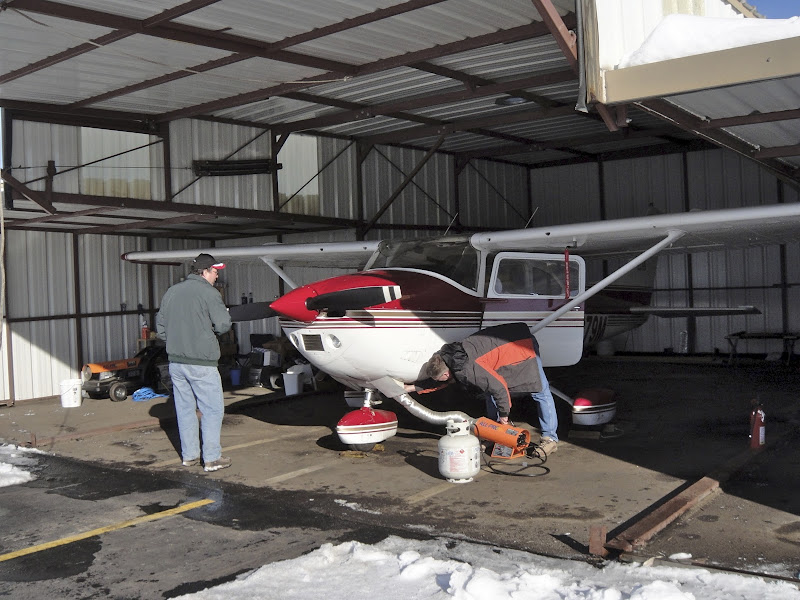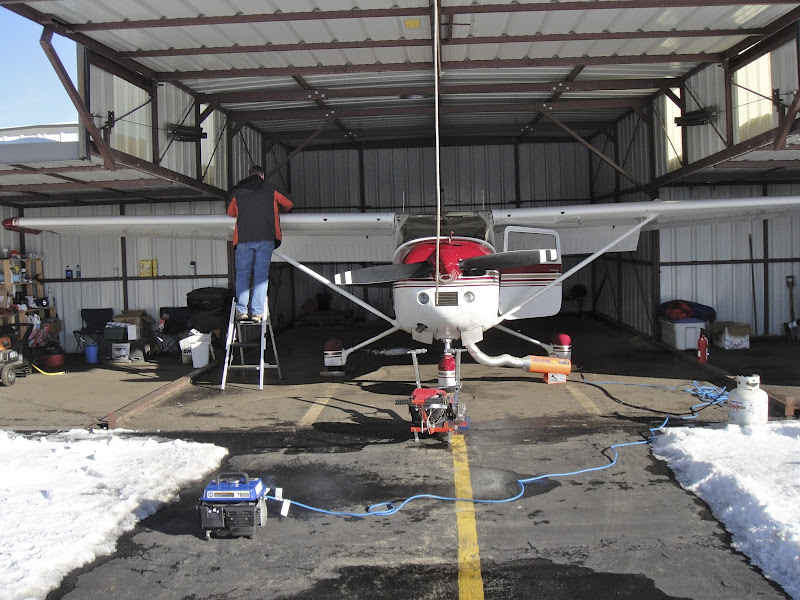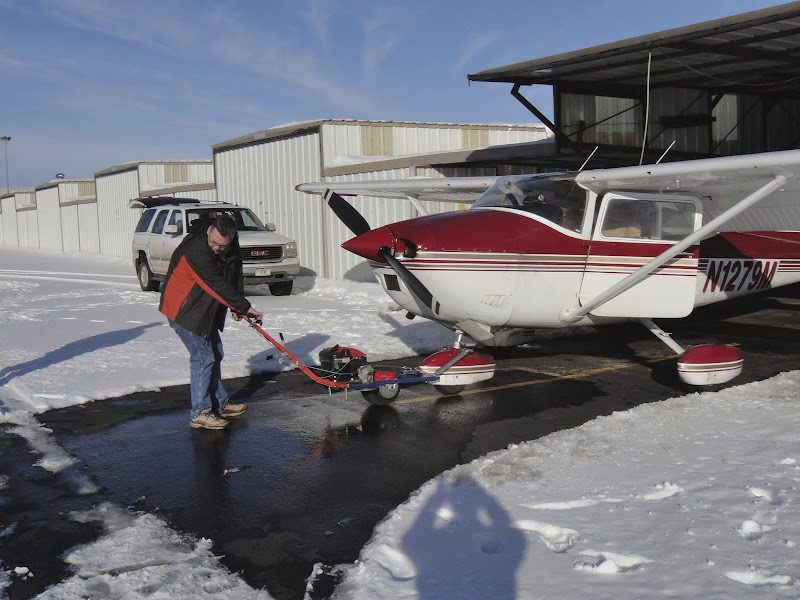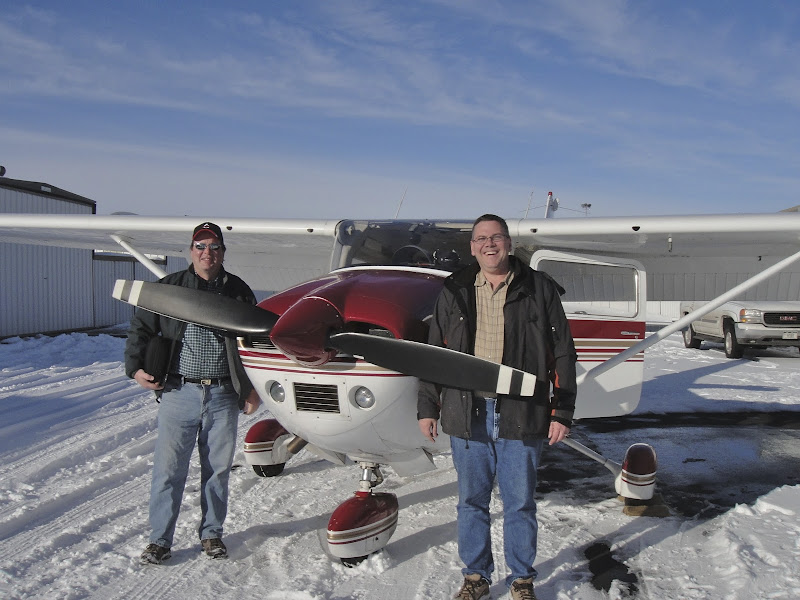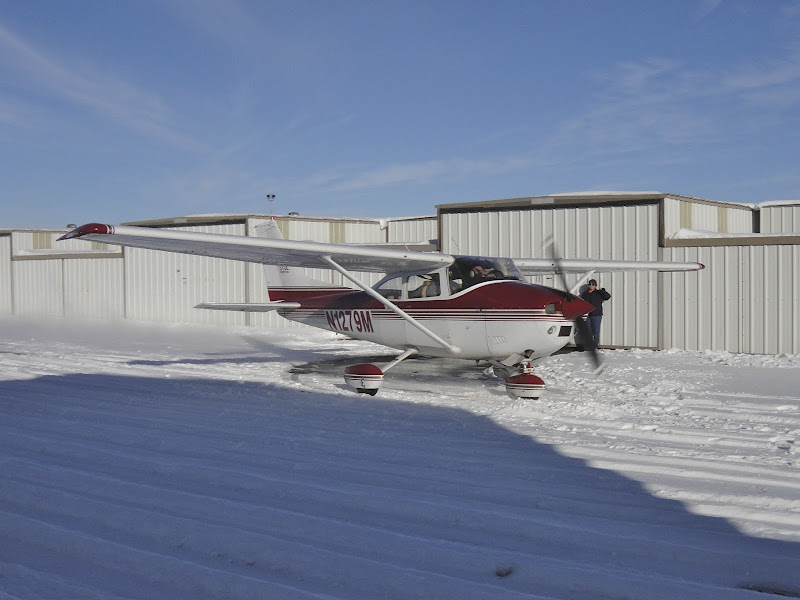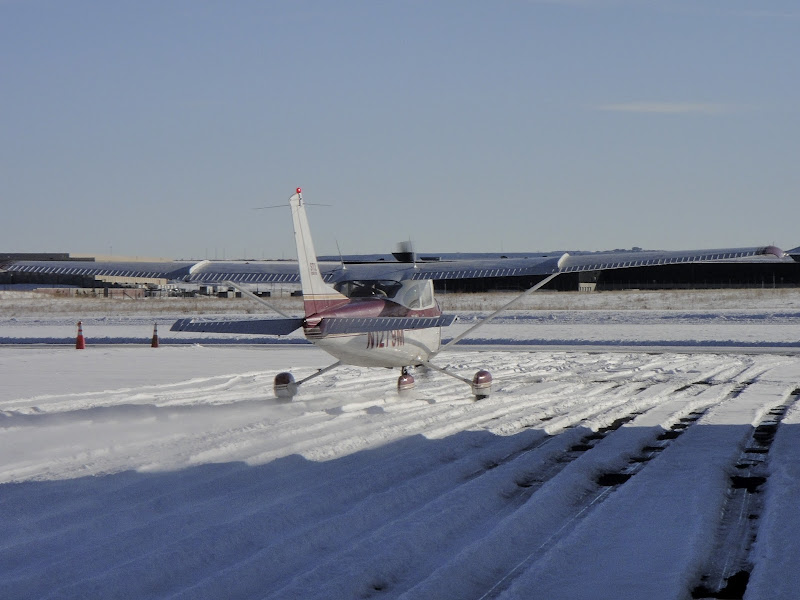I've been pretty swamped and haven't had much time to comment as much as I'd like on this discussion - but I just can't help it at this point. So, here we go...
I knew you'd chime in eventually... and judging by the signs that things were getting busier for you at work and in "real life" that I was delaying taking up all of your time, I'm chuckling at the "I just can't help it" comment. Thanks again for taking all the time.
I have nothing set in stone regarding the Ts. I recognize that as an instructor I need to teach different students in different manners. When David was here I stuck the T's on his panel using a post it note.
And honestly I'm doing them in my head when I'm not behind. I don't find it a bad technique at all. The part I couldn't keep up with last night was
verbalizing them out-loud.
That's the part Jer/ was demanding and I couldn't get it out of my mouth. Not while I was that far behind, anyway.
My instruction technique varies dramatically depending on the student because I recognize that different people have different personalities and learn in different manners. I strive to figure out each student and constantly adjust to accommodate their needs.
I bet Jer/'s does too... I don't want to make it sound like it doesn't. I am just sharing how it *felt*...

I've yet to find a situation where it makes more sense to stomp on rudder pedals to make turns. This is really airplane specific and many will have a heavy tendency to return to the original heading making your uncoordinated effort worthless. In fact, you have to stomp hard enough to go PAST the desired heading so that when it comes back after releasing the rudder it'll end up where you want.
No thanks, couple the ailerons to the localizer needle and don't let it move. Master this and you'll be able to track an ILS to landing with nothing but the CDI - gyro free. Notice small changes and correct them instantly. You'll be busy - but you should be.
And I bought into this "philosophy" as you taught it... when I arrived in Lincoln I thought I could fly an ILS with just headings... you proved to me that didn't work as you got closer in.
I also couldn't verbalize it, but you just nailed what the problem was last night... the tendency to go back to the original heading with the rudder turns. I wasn't using even CLOSE to enough rudder to overcome that. I was trying to figure out how much to use and got about three or four good stabs at it and the approach was over, and I was way off the localizer.
I'll give Jer/ credit on one item here... he suggested that during such activity that I use continuous forward pressure on BOTH rudder pedals throughout the approach... gives a better "feel" in the feet for what's going on. I was doing the "no pressure on the unused foot" technique as I always have... I tried the forward pressure thing on the ground, and I like the feel, but I'd need practice. I remember one glider instructor also recommending this long long long ago. (And Jer/'s a glider instructor too...)
Let me throw another one in here... part of that "feel" I assume is also sounds, and the Lightspeeds are really screwing me up there. I couldn't hear the usual airspeed changes, etc...
I'm sure they're there, but it's a completely different sound than when using my DC headclamps.

I think I really need to go back to the DCs for the moment and that would help a lot. Changes aren't a good idea right at the moment.
I played with turning the Lightspeed ANR on and off on the way home, and it still doesn't sound quite the same. I'm REALLY going to like ANR in the long run, but I think the DCs are going back on my head for the time being.
I'll work on "transitioning" to the Lightspeeds under the hood later.
This is once again airplane specific. If you were flying around in a retract I'd have some comments about making configuration changes on the move.
Again to be fair, Jer/ also said this. And I remember it from my time in the Mooney and the 172RG. His quote was, "The next STEP after Instruments is retracts and you need to leave things alone on the runway." I get it. And I also know the dangers of building muscle memory and habits that will have to be broken if I do that, but there's some assumptions involved with his statement...
A) Am I really going to be flying retracts again in the future? With the industry's move to the latest "desirable" aircraft for personal transportation being NON-retracts and outperforming the retracts hands-down... probably not... unless I decide to chase the Commercial for some reason.
B) Am I really planning on "the next step" right now? I mean really? I'm a recreational pilot. Stepping up to retracts and multis and whatever... isn't in the budget for personal flight, and likely isn't in the planning for any aviation goals my the near future at all. The only possible exception to that is maybe a Commercial ticket. Kent's stories of jumping in jets and wandering the Wisconsin countryside on a whim aside, I don't see a need for it. I have zero plans to make a living in an airplane right now.
If that changes, I'll let some instructor slap my hand off the flap handle about a hundred times in a row and break my habit of retracting them, but I'm very comfortable doing it in the 182. It probably is a bad habit, but it simply doesn't apply right now. Grab a ruler and smack my knuckles later, I'm fine with it.
Sometimes I have to load students up to the poitn where they break - because I need to see where that point is and I want them to know how to recover from mental defeat. But you've got to give them a breather.
It's ABSOLUTELY ridiclous to require a guy that is falling further and further behind the airplane to go FASTER. Why go faster then 90 knots if you can't handle it? I teach people how to RECOVER from being over-loaded and that means you slow down and you THINK.
Pilots will get confused. They will fall behind. When that happens they will fall back to their training for how to recover from such a situation. Going faster and making things harder most certainly should not be the response.
And honestly, I was falling back to my training from working with you -- I was prepared to fly that damn airplane around half of Northern Colorado at 90 knots for two hours if it meant I could get caught up and stay caught up.
Once we shoved the power up, it just added to the confusion. The "if we don't speed up we're never going to get there" comment just didn't make any cognitive sense to me... I was thinking, "If I don't get ahead of this airplane we'll get to the crash site faster."



This really is a tough issue. I can feel airplane energy pretty well and really don't touch a thing unless it absolutely has to happen like RIGHT NOW. In that case, I'm going to protect myself and my certificate. It sure doesn't happen very often though and I'll let someone make a bad landing as long as it's not putting me or the bird at risk. I don't recall an instance of where I ever felt any desire what-so-ever to touch Nate's yoke during the landing or takeoff phase of the 30 hours he spent here. That includes a lot of slow landings - but I have a pretty good feeling for how slow a 182 can fly and I don't pay any attention to the airspeed indicator.
Nate's panel makes it pretty difficult for a right seat instructor to see the instruments. The values on the airspeed indicator aren't visible what-so-ever so it's possible that Jer's inability to see the values caused him to respond when it wasn't needed. I wasn't there and I won't pass judgement on his decision.
I also completely understand why it happened. I want Jer/ to see slow flight in the aircraft before any further flights, if there are any.
You got to see it the first night (and got to laugh at me trying to hold it level) at 30 knots or so, for 20 minutes or more.
(Time compression -- I have no idea how long we actually did that. Felt like about three years, to me! Ha!)
I know we eventually decided that "slow flight" under the hood had to be flown faster because the airplane would wallow back and forth still under control but requiring full control inputs to get it level again and when it wasn't level, I couldn't hold a heading.
We ended up learning that something like 45 knots -0 +5 seemed to work very well, kept the horn on, and the airplane still had nice positive roll control. Any pitch up at 45 and it would rapidly bleed to 35 and the roll one direction or the other would start. I'm sure there's some superman pilot out there (maybe even Jesse or Jer/) who could hold 35 knots in my airplane with the engine roaring and hold heading under the hood, but I'm definitely not there yet, and let's get real... getting that slow in IMC would be ridiculous and reckless -- but it's quite fun VMC out in the practice area!!

I cannot imagine starting a lesson without SOME form of pre-brief and on my first flight with a student it's going to take some time.
Yeah, I can't figure that one out. Perhaps Jer/ wanted to see me fly to see just how much work we had to do. I don't know. Again, I want to be fair to him.
Do you recall the moment I applied force on your yoke? (had nothing to do with takeoff or landing)
No. In fact, thinking back I didn't know you even did... maybe during a climb-out?
I remember
plenty of times where you had to hint at which axis of flight was going completely out of whack as my scan broke down completely, and times where that one would lead to the next one breaking down, and the next... and the next... (HAHAHA... not really funny, but it was part of my learning process, so I'll own up to it...).
You probably wondered at times if I'd ever "get it". I was squarely back in that mode last night and really cranky about it. I think I'm going to have nightmares about the phrase, "Where are you going?" for years to come after this training experience... probably rightly so.

That's too bad. It sounds like he has a lot of knowledge and he could help a lot more pilots and be a more effective instructor if he understood how to adapt.
I
DON'T want to make it sound like he can't. Not at all.
This discussion is almost unfair to him at this point, and I'm somewhat wondering if I should ask him to join in.
There's been enough written that he could be completely insulted by my comments so far if they're not accurate to what he was doing or thinking or setting up for later lessons.
Heck, maybe he's already reading. That'd be funny. Or embarrassing. I don't know which.
I'm very cognizant that I'm putting this out there on the line for all to see... struggles and all.
I think it's good for us to document our struggles, and I enjoy reading other's posts about theirs... but there's a downside... people aren't used to having documented proof of how they saw things or felt thrown in their face years later, and there's a lot of misunderstandings brought on by all this technology.
All I can say in defense of posting all these thoughts is, "I gotta be meeeeeee.... I gotta be meeeeeee..."

(Remember the Far Side cartoon of the penguin in the middle of a huge flock of penguins who all look the same, singing that? Yeah...)
I choose my battles and I treat different students differently. Students I've taught from DAY one do everything just like I'd prefer.
I DO recognize that students I *haven't* taught from day one will operate in a manner different than I do. I absolutely do not force my techinques on them unless I feel that technique would improve their ability greatly. I simply do not care how you choose to poke frequencies in your radio. If it appears your method works for you, then as far as I'm concerned, that's how you should be doing it -- regardless of how I'd do it.
For example, you tend to alternate between one radio or the other generally starting with one on the ground then switching to the other when taking the air. Whereas I tend to do all transmitting on one radio and use the other for monitoring various things or talking to FSS. I never did try to force that on you, nor did I even mention it, because I saw that your method worked for you.
You're not a 5 hour student pilot that has no idea how anything works. You do not need all of your methods of operation changed and doing so will not help you learn. You've had several hundred hours of aviating to discover what works for you.
Appreciate that. I like my radios just the way I did 'em.



I don't remember why or where I learned that technique, but I barely remember something way back in my brain that by doing it that way, I've not only listened on both radios but also transmitted on both of them BEFORE leaving the ground, and if something is wrong with a transmitter, it'll be known before takeoff.
Of course, your method would also tell if #1 had a bad transmitter, and the likelihood of #2 ALSO having one is about zero, especially if it rarely gets used!
So either works and the theory is blown. But that's the theory that stuck in my head sometime back. Don't remember why.
I also have a weird habit of putting CTAF frequencies in the bottom radio but "real" controller frequencies in the top. Did you notice that, or was I so bad at setting up for CTAF calls that I never got it set that way?

I do not know where that CTAF habit came from at all. I suspect it's something subconscious to keep ATC segregated from CTAF so I don't make a CTAF announcement on ATC, but I think I did that once anyway while we were flying... because I forgot to flip the COM1/2 switch.
Maybe more than once. So perhaps that another technique that's actually "busted" but stuck in my head for some reason.


Jer/ did something I don't remember you asking of me, which was interesting... Identify the DME. Hmm... okay. Certainly technically correct.
More Morse Code... YAY!

Ha.
Alright, enough over-analyzing... I could do this all week...
I didnt understand what you said when the stall fences "sing" because I never heard them before, but I slowed down to 55 on final and boy they "sing" pretty good. Sounds alot like the cloud whistle.
YEP!!! Okay funny story from Jesse and I's flying... the Cessna cloud whistle started, and Jesse pointed it out (I didn't notice it at first). I was shocked.
I HONESTLY thought the whole cloud whistle thread was just all you PoA'ers setting us newbies up for a Snipe Hunt. I told Jesse that and he started laughing.
Yes, Cessnas really do whistle in the clouds. It's eerie.
And yep... the stall fences and droopy ailerons make a similar sound as you pitch to about right where yours does... 55 knots or so. It sounds a little more like a "sucking" sound than the cloud whistle. Air trying to detach from the wing, but getting blocked by the fences or hitting the tops of them where the most noise would be transmitted to the airframe, I assume.
I typically pitch right to where I *hear* that start and then don't pitch ANY higher during the over-the-fence portion of the landing.
I don't even have to look at the AS indicator to know the speed at that point.
Any harder pull, it gets louder and the sink rate goes up. Relaxation of back pressure, it fades away. You can hold that speed all day long without looking at the ASI by just listening. (I've also practiced it at altitude, and recommend that...)
If I pitch to that speed by sound, and then let the aircraft fly down to the runway, all it takes is a tug to get the horn to come right on at the flare and if the power at THIS altitude is all the way out, it'll stop flying right this second when you pull past landing attitude... therefore sometimes I add just a blip of power to arrest that sink rate here. Unfortunately that built a bad habit for down lower, and a couple times I was just as surprised as Jesse when I found myself leveled off at a very slow speed with a touch of power in and "hovering" the landings. Jesse figured it out faster than I did... "Leave the power out."
But, but, but!!!... it'll plop on if I do that! (My brain was thinking...). After ballooning ANOTHER landing I decided, "He's probably right, you know... he is an instructor after all... you idiot..." and pulled the power and left it off...
HEY! Whaddaya-know! It landed!



I REALLY REALLY REALLY want Jesse to visit sometime and see the takeoff, climb, and landing speeds here in my airplane in Denver sometime. The amount of runway I chewed up launching last night even had me thinking, "Where's all the power?" I knew the numbers in my head, and it lifted off right where it always does on Runway 10 departing KAPA... but after a week at super low DA, I had already come to expect quicker takeoffs. It also messed with my climb out speeds on the missed approaches last night. I was sloooooow... trying to get more than 600 FPM out of it.



One problem down in Lincoln was the super-wide runway at night with the lights WAY out there on either side... during the first half of the week I was staring in front of the nose of the airplane because the Flap 40 groundspeed is sooooo slow down there, it looked like I was going to become a really slow lawn dart in a very big wide runway.

Later in the week, I had plugged in the brain again somewhere along the line and forced myself to look at the end of the runway... and the landings mostly straightened out. I think. And they probably got slower.
(Sorry if I was making you nervous Jesse! I also keep forgetting about the AS being virtually impossible to see from the right seat.)
Since I'm sharing about landings, the other thing it's going to be REALLY hard to knock out of my brain is shooting for the numbers.
Jesse and Jer/ both have had to remind me that you're shooting for the touchdown zone markers in IR flying, and I've never felt a need to "fly all the way down there" to land! That's just a waste of perfectly good runway! :wink2:
Just about every landing I was fighting with my "numbers aiming" habit or just beyond... my aim point in my head for almost 400 hours has been the top of the numbers or so, with a flare that ends up a little ways beyond it... not right on 'em, or way back at the line, but aiming for 1000' down is still a weird feeling. I'll get over it.

Something others planning on flying IR might as well know, I suppose. If you're enjoying your short landings... knock it off. Fly way down there to those big fat white painted things... they actually do have a purpose apparently.

I may have this wrong, but I also believe you were both hinting that not going for the touchdown zone markers is a "bustable" item on a check ride with some/all DPEs... is that correct?
I can't find it anywhere in the documentation, but maybe I missed it in the PTS.
Is it a relatively new thing, because I can hear my Private Instructor in my head saying "runway is made, power to idle" and from that point... there was no shooting for any particular spot at first, and then later for short field, it was dead in the center of the numbers. He also used to joke that I "like" full flap slow landings, and it was my no flap fast landings that I usually sucked at and required more work.
BTW: I've avoided opening up that PTS booklet for a number of days now so I don't see how badly I'm doing.



Thanks all for lettin' me share... tonight the WX goes to crap, and I just got a note from Jer/ saying he enjoyed it and "I hope we can make rapid progress from here"...
Uuuggh!!... it's so damn hard to tell if that whole thing was "trial by fire" and was just to see where I'm at and how this would go if I continue with him!!!!
It's incredible to me how two instructors of what (at least at the moment) seem to me to be completely different teaching styles -- can both turn out safe competent IR pilots who may be flying completely differently inside their heads at the end, but doing everything to better than check ride standards.
That doesn't sit well with my computer-guy brain.


Computers only do things ONE way. Sigh... Humans! We're so messy!















